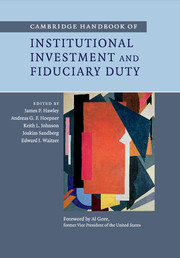Book contents
- Frontmatter
- Contents
- List of figures
- List of tables
- List of contributors
- Foreword
- 1 Introduction
- Part I Fiduciary duty: a global outlook
- Part II Fiduciary duty and the landscape of institutional investment
- Part III Challenging conventional wisdom on fiduciary duty
- Part IV Towards a broader interpretation of fiduciary duty
- Part V Beneficiaries’ roles and viewpoints
- Part VI Fiduciary duty and governance
- 30 Investors and global governance frameworks: broadening the multi-stakeholder paradigm
- 31 Promoting corporate sustainability through integrated reporting: the role of investment fiduciaries and the responsibilities of the corporate board
- 32 Reporting and standards: tools for stewardship
- 33 US corporate governance, fiduciary success and stable economic growth
- 34 Fulfilling fiduciary duties in an imperfect world – governance recommendations from the Stanford Institutional Investor Forum
- 35 Addressing the participation gap in institutional investment: an assessment framework and preliminary results
- 36 The costs of fiduciary failure – and an agenda for remedy
- Index
- References
33 - US corporate governance, fiduciary success and stable economic growth
Published online by Cambridge University Press: 05 April 2014
- Frontmatter
- Contents
- List of figures
- List of tables
- List of contributors
- Foreword
- 1 Introduction
- Part I Fiduciary duty: a global outlook
- Part II Fiduciary duty and the landscape of institutional investment
- Part III Challenging conventional wisdom on fiduciary duty
- Part IV Towards a broader interpretation of fiduciary duty
- Part V Beneficiaries’ roles and viewpoints
- Part VI Fiduciary duty and governance
- 30 Investors and global governance frameworks: broadening the multi-stakeholder paradigm
- 31 Promoting corporate sustainability through integrated reporting: the role of investment fiduciaries and the responsibilities of the corporate board
- 32 Reporting and standards: tools for stewardship
- 33 US corporate governance, fiduciary success and stable economic growth
- 34 Fulfilling fiduciary duties in an imperfect world – governance recommendations from the Stanford Institutional Investor Forum
- 35 Addressing the participation gap in institutional investment: an assessment framework and preliminary results
- 36 The costs of fiduciary failure – and an agenda for remedy
- Index
- References
Summary
Introduction
Economic growth depends crucially on productivity growth – the rate at which businesses increase their efficiency. There are troubling signs for future productivity growth. The productivity acceleration that started in the mid-1990s eventually disappeared in the mid-2000s. This productivity slowdown followed years of historically low levels of net corporate investment, which represents the actual additions to the country’s capital stock after capital replacements have been accounted for.
Key business investments, such as equipment or workforce development, have languished. Investment has been low amid rising corporate profits. Corporations instead used their additional resources to increase share repurchases and dividend payouts.
The prioritization of share repurchases and dividend payouts over productive investments reflects a corporate penchant to pursue activities that boost share prices in the short run at the expense of long-term productivity growth.
This prioritization is partially related to the US corporate governance structure’s short-run biases. US corporate governance institutions include corporate executives, shareholders and the board of directors. The board of directors and shareholders are supposed to provide checks and balances on managers. Managers nowadays have, by design, a short-term orientation in their resource allocation decision. And these corporate executives wield a disproportionate influence over corporate resource allocation because other stakeholders can currently offer only a limited counterbalance. Executive performance measures are hence tilted toward shortrun share price run-ups with limited countervailing forces in place. Corporations may hence reap shortterm proi ts to boost their share prices, but slowly erode the basis for long-term productivity growth.
- Type
- Chapter
- Information
- Publisher: Cambridge University PressPrint publication year: 2014



